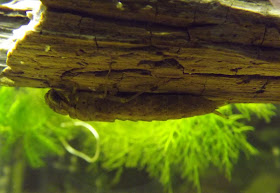It was bound to happen sooner or later. The
warm weather and recent rains have spiked most rivers into muddy torrents –
making this a good time to focus on lake fishing. Admittedly I missed the
spring window of opportunity for rivers like the Red Deer and upper NSR this
year; instead choosing to ply the local trout lakes.
Local lakes have been fishing good these
past two weeks with many nice fish in the three or four year class being
caught. Chironomid and Callibaetis hatches have been off and on depending on
the weather, and the dragonflies have just started to emerge on most lakes.
This past weekend at Chain Lake saw a few dozen adult American Emeralds flying
along the shoreline (Cordulia shurtleffii
– usually the first species to emerge), and Spiny Baskettails (Epitheca spinigera) should be coming off
heavy over the next week or so.
The first hatches of dragonflies are good
news for most anglers since the large, active nymphs tend to draw the attention
of larger fish (the tiddlers tend to focus more on the midges and mayflies). Trout
can be quite gluttonous during dragonfly nymph migrations; I have caught big trout
that were stuffed so full of these bugs that the fish were literally regurgitating
handfuls of live, squirming nymphs as they were being released. If you want to
bypass the newly stocked runts of the year, try working a dragonfly imitation along
the bottom – either in 12 to 15’ of water during the day, or in the
shallows as dusk approaches.
As far as dragonfly nymphs go, there are
basically two types to consider: Sprawlers in the families’ Corduliidae and
Libellulidae, and crawlers (sometimes called Darners) in the family Aeshnidae.
Aeshnidae nymphs are long and relatively
narrow in profile and are generally seen in shades of brown or dark olive. The
nymphs have a two to four year lifecycle and can be up to 50 mm long. These
crawlers like to lurk on dead logs and stumps, stalking unsuspecting prey (virtually
anything they can subdue – including small minnows). Their preference for woody
debris means that they are most often found in shallow water but they
occasionally venture deeper if conditions allow.
.jpg) |
| Aeshna sp. (nymph) |
Corduliidae and Libellulidae nymphs have a
shorter and wider profile, and are somewhat flattened so they can lie tight to
the bottom. Nymphs have a two to three year life cycle and can be up to 30 mm
long. Their color tends to match whatever substrate they are on (usually shades
of green, olive, brown, or tan). They are also covered in fine hairs that give
them a ragged appearance. The hairs also tend to trap sand or silt adding to their camoflage. Sprawlers lie in wait
on the bottom for other invertebrates to venture within striking range. These
nymphs will often range out into deeper water (as deep as 12-15’).
.jpg) |
| Epitheca spinigera (nymph) Family: Corduliidae |
Regardless of the species, all dragonfly
nymphs have internal gills with the gill chamber opening located on the tail
end. Their most common mode of travel is a slow crawl but when they need to get
somewhere fast (or escape from predators), they can forcefully expel water from
the gill chamber giving them jet like propulsion.
I have posted a video of the migrating nymphs (both sprawlers and crawlers) so you can get a sense of how they look and act:
The video should give you a few ideas as far as what flies to use and how to present them. If I have time this week I will post instruction on how to tie two versions of my favorite pattern – the Marabou Dragon.
With the multi-year lifecycles, these
nymphs are available to trout year round, making a dragonfly nymph imitation a
good searching pattern if nothing else is emerging. When ready to emerge, the
nymphs will migrate into shallow water and wait till dark to make their way to
shore where they crawl out onto rushes and grasses to emerge under the cover of
darkness. It is during these inshore migrations (usually late afternoon to
evening) that large trout will key in on the more active and exposed nymphs.


No comments:
Post a Comment